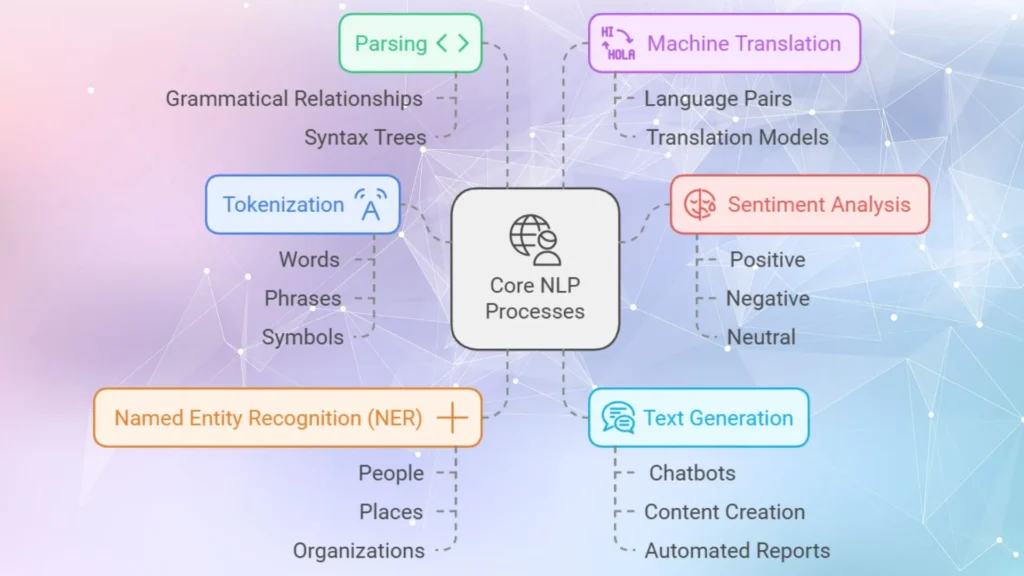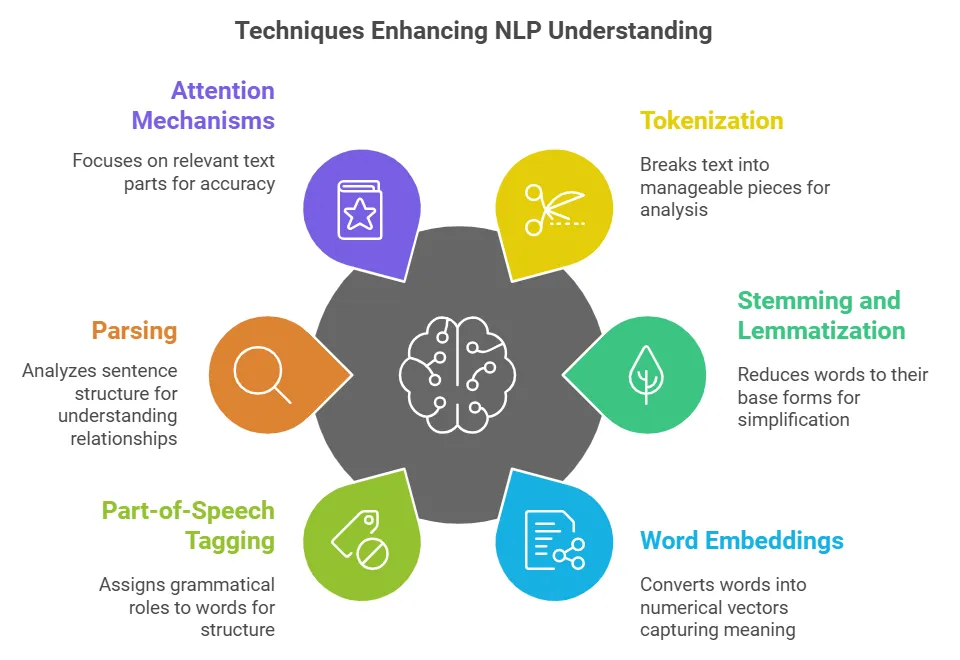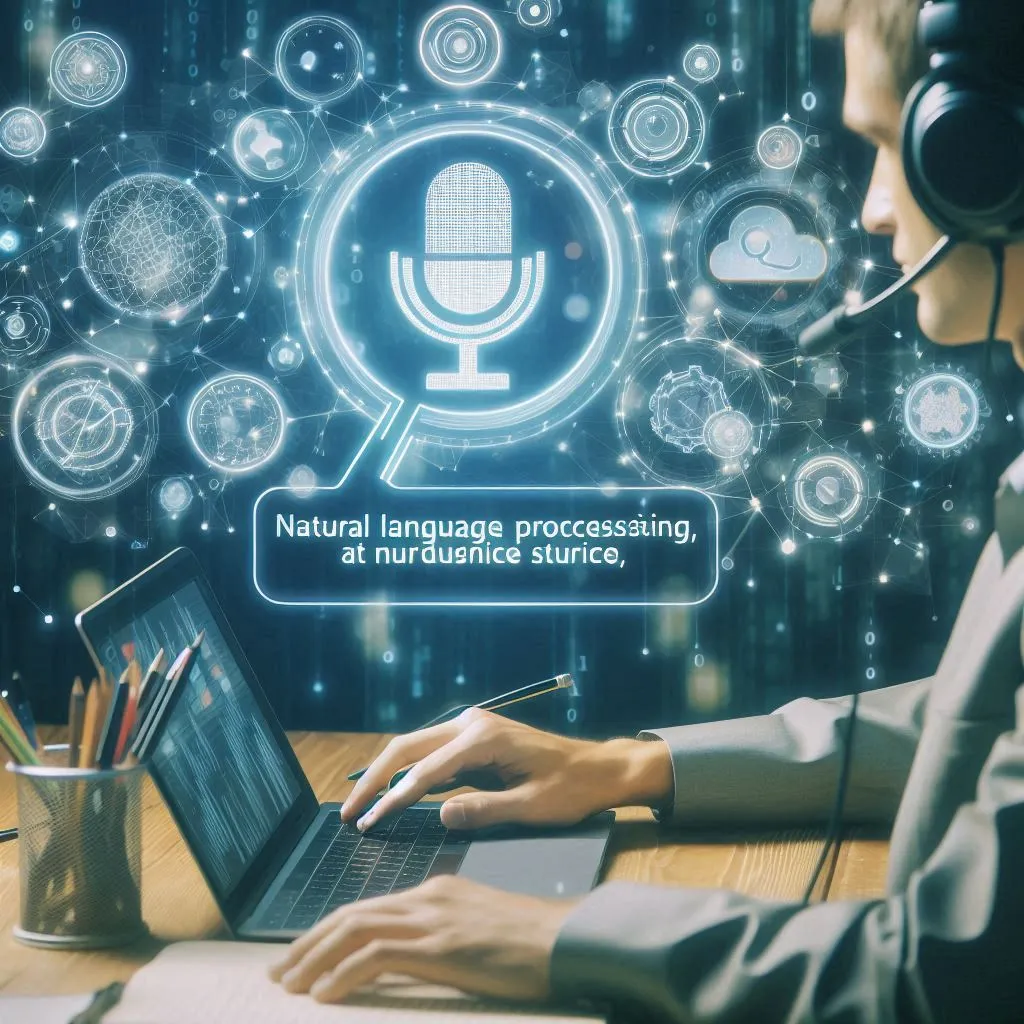Natural Language Processing is a field of artificial intelligence that focuses on the interaction between computers and human language. With the help of NLP, machines can understand, translate and respond to text data in meaningful ways. This technology is behind many tools that we use every day, like digital assistants such as Siri and Alexa and text prediction feature in messaging apps.
In this post, we shall explore how does Natural Language Processing work, how NLP works in chatbot, including key tasks, techniques and real world applications. We shall also discuss the challenges NLP faces and how advanced models like GPT and BERT have changed the field and its effect on various industries.
What is Natural Language Processing?
Natural Language Processing (NLP) is a field of AI that focuses on the interaction between computers and human language. At its core, NLP enables machines to process and understand text and spoken words in a way that is valuable for various applications. The goal is to allow computers to perform useful tasks with text data, such as translating languages, analyzing sentiments or moderating content.
NLP works through a series of processes, such as breaking down sentences, understanding context and making sense of grammar and syntax.

Key Concepts in Natural Language Processing
NLP relies on many central processes to understand and generate text. Some of the main tasks include:
1. Tokenization: Breaking down text into smaller units, or “tokens,” which can be words, phrases, or symbols.
2. Parsing: Analyzing sentence structure to understand grammatical relationships.
3. Sentiment Analysis: Determining the emotional tone of a piece of text.
4. Machine Translation: Translating text from one language to another.
5. Named Entity Recognition (NER): Identifying names of people, places or organizations in a text.
6. Text Generation: Producing new, coherent text based on input data, such as in chatbots.
Each of these tasks requires different approaches and algorithms, from simple rule based models to complex deep learning architectures.
Main NLP Tasks and Their Applications
Let us explore some essential NLP tasks, their practical applications and how they are transforming industries.
1. Sentiment Analysis
Sentiment analysis detects the emotional tone in text data, which identifies whether the sentiment is positive, negative or neutral. This task is particularly useful for analyzing customer feedback or social media data.
Applications:
– Customer Service: Businesses use sentiment analysis to check customer satisfaction and respond to complaints. For example, social media monitoring tools analyze tweets about a brand to understand public opinion.
– Market Research: Sentiment analysis helps brands to understand trends and customer reactions to new products.
2. Language Translation
Machine translation automatically translates text from one language to another. Early translation systems relied on basic rules, while modern NLP models use neural networks to capture linguistic nuances.
Applications:
– Global Communication: Language translation breaks down language barriers, which makes it easier for companies to communicate with customers worldwide. Google Translate and Microsoft Translator are main examples.
– Content Localization: Businesses use machine translation to localize content for specific regions, to expand their reach and market.
3. Content Moderation
Content moderation means identifying and filtering inappropriate or harmful content. NLP models help platforms like social media sites to maintain a safe environment for users by detecting offensive language, hate speech or spam.
Applications:
– Social Media: Platforms like Facebook and X (formerly Twitter) use NLP to filter out abusive language and harmful content in user generated posts.
– Online Marketplaces: E-commerce sites employ content moderation to ensure that product descriptions and reviews meet guidelines.
4. Named Entity Recognition (NER)
Named Entity Recognition (NER) identifies names of people, organizations, locations and other entities in a text. This task helps to organize information and make it easier to analyze large volumes of unstructured text data.
Applications:
– Healthcare: In healthcare, NER extracts entities like medication names, symptoms and diagnoses from clinical records, which helps to analyze patient data.
– Finance: Financial firms use NER to extract information about companies, stock symbols and events from news articles, to support investment decisions.
Techniques Used in Natural Language Processing
NLP relies on many techniques to understand and process language. Here are some of the most common techniques:
1. Tokenization
Tokenization splits text into individual words or phrases. For example, the sentence “Natural language processing is fascinating” would be broken down into tokens like “Natural,” “language,” “processing,” and “fascinating.” Tokenization is essential for further analysis, as it prepares text data for processing.
2. Stemming and Lemmatization
Both ‘stemming’ and ‘lemmatization’ reduce words to their base or root forms. For instance, “running” becomes “run” through stemming, while “better” is transformed to “good” through lemmatization. These techniques help simplify text data, which makes it easier for algorithms to analyze.
3. Word Embeddings
Word embeddings, like Word2Vec and GloVe, convert words into numerical representations that capture semantic meaning. They represent words in a vector space, where words with similar meanings have closer vector representations. This technique enables algorithms to understand the context and relationships between words.
4. Part of Speech Tagging
This technique assigns grammatical tags (e.g., noun, verb, adjective) to each token in a sentence. Part of speech tagging helps models to understand the grammatical structure of a sentence, which enables them to analyze the relationships between words.
5. Parsing
Parsing analyzes the syntax in structure of a sentence. This step helps models understand how words are related and how they function within a sentence, which is very important for tasks like translation and text generation.
6. Attention Mechanisms
Attention mechanisms allow NLP models to focus on the most relevant parts of a sentence while making predictions. Attention is particularly useful in handling long sentences, as it helps the model to remember important information.
Example: In a translation task, an attention mechanism ensures that each part of a sentence is translated correctly, even in longer and complex sentences.

NLP Tools Driving Innovation: GPT and BERT
GPT (Generative Pre-trained Transformer)
GPT, developed by OpenAI, is a transformer based model that excels in text generation, language translation and summarization. GPT’s architecture allows it to generate coherent and contextually accurate text, which makes it ideal for chatbots and content creation.
BERT (Bidirectional Encoder Representations from Transformers)
BERT, developed by Google, is another transformer based model that processes text bidirectionally, meaning it considers both the left and right context of each word. BERT is particularly effective in question answering, named entity recognition and other tasks where context is essential.
Real World Applications of NLP
NLP has a wide range of applications and many industries have integrated NLP solutions to streamline processes, improve customer experiences and get information from data.
Let us explore a few real world applications in different sectors.
1. Business: Chatbots and Virtual Assistants
Chatbots and virtual assistants are some of the most popular applications of NLP in business. By understanding and responding to customer inquiries, chatbots can provide customer support 24/7, which reduces response time and improves customer satisfaction.
Example: Companies like Amazon and Uber use chatbots to handle customer inquiries, which allows their support teams to focus on more complex tasks. NLP enables these chatbots to understand questions and respond accurately.
2. Healthcare: Medical Data Analysis
In healthcare, NLP is used to analyze medical records, research papers and clinical notes. NLP can help healthcare providers extract important information from patient records, streamline diagnosis processes and stay updated on the latest medical research.
Example: IBM’s Watson Health uses NLP to analyze vast amounts of medical literature and clinical data, assisting doctors with diagnosis and treatment recommendations.
3. Customer Service: Sentiment Analysis
Sentiment analysis helps companies to check customer satisfaction by analyzing feedback and reviews. By understanding customer sentiment, companies can improve products, refine marketing strategies and strengthen brand loyalty.
Example: Twitter uses sentiment analysis to check user reactions to trending topics and public sentiment towards brands, events and even political movements.
Suggested Image: Examples of applications in different sectors, such as healthcare, customer service and business.
4. Finance: Automated Report Generation
In finance, NLP is used for tasks like extracting information from financial statements and generating automated reports. For example, banks use NLP to summarize quarterly earnings reports, which saves analysts’ time and provides quick information to investors.

Challenges in NLP
Despite the advancements, NLP still faces challenges due to the complexity of human language. Here are some of the main hurdles:
1. Ambiguity and Polysemy
Human language is full of ambiguities. Words can have multiple meanings, which makes it difficult for machines to interpret the intended sense without context. For example, the word “bank” could refer to a financial institution or the side of a river, depending on the sentence.
2. Understanding Context and Sentiment
Understanding context, sarcasm and cultural nuances is difficult for NLP models. While tools like BERT have improved contextual understanding, it is still difficult to translate hidden emotions and complex expressions.
3. Sarcasm and Irony
Detecting sarcasm and irony is a notorious challenge for NLP, as it often requires understanding tone and context rather than just words. For example, sentiment analysis tools, may misinterpret sarcastic comments as positive if they don’t understand the underlying intent.
4. Bias in NLP Models
Many NLP models are trained on large amounts of internet data, which can introduce biases. If not corrected, these biases can lead to unfair or discriminatory results.
5. Resource Intensive Training
Training NLP models requires significant computational resources, as well as large amounts of labeled data. These requirements make NLP model development costly and time consuming, especially for complex models like GPT-3.
Conclusion
Natural Language Processing (NLP) is transforming how we interact with technology, by bridging the gap between human language and computer understanding. From NLP has many applications across industries, like chatbots, sentiment analysis, content moderation and translation etc. This makes it possible for businesses to deliver better services and make informed decisions.
Despite its challenges, advancements in models like GPT and BERT have pushed NLP capabilities forward, which enabled more sophisticated and accurate text analysis. As the field continues to grow, NLP will discover even more powerful applications, which will bring us closer to seamless human machine interactions.
The future of NLP promises exciting possibilities, like enhanced customer experiences and efficiency across industries. As technology advances, NLP will continue to play a central role in shaping the future of AI driven communication and data analysis.

